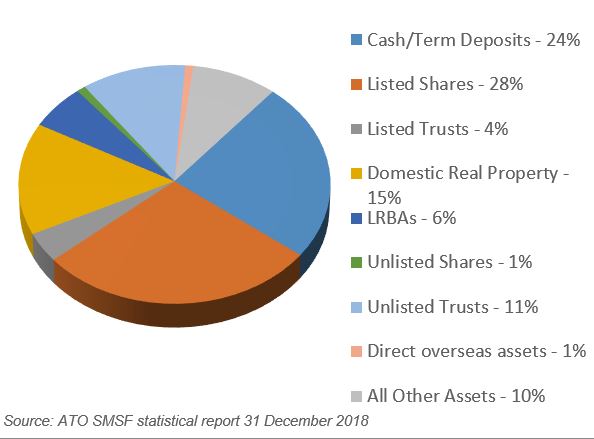
By Phil LaGreca
Every quarter the ATO releases an SMSF statistical report and this is usually followed by an influx of commentators, usually non-SMSF specialists, deriding the SMSF sector for asset class concentration and lack of diversification particularly in relation to international exposure. These claims are usually based on false assumptions that are not from the ATO but by the commentators.
These key assumptions are that the data is as at the quarterly date, the ATO is reporting asset allocation and all superannuation allocations are the same.

So why should these assumptions be looked at more closely and the data not excessively used for determining how SMSFs invest? To do this we need to examine where the data comes from and what is its real use.
What date applies to the data?
When we talk about investment data for SMSFs, the ATO’s source of information is Section H - the SMSF regulatory return that is lodged each year. The timing of the actual lodgement will depend on the SMSF which means its return may not be lodged until May the following year. As a consequence of this the primary source of data now is still the 2017 returns and not the 2018 returns.
This means the 31 December 2018 statistical report, published in March 2019, is a combination of the 30 June 2017 data weighted with a proportion of data that comes from:
This of course mean any actual investment decisions made by all SMSF trustees are not directly reflected in the data. This is most obviously reflected in the cash holdings for SMSFs.
Most contributions received by the SMSF sector are NOT employer contributions and particularly Superannuation Guarantee (20% of all superannuation contributions received by SMSFs) as is the case for APRA Funds (80% of all contributions made to these funds) which are required to be paid quarterly throughout the year.
Additionally, most of the member contributions are made in June each financial year and thus not invested by 30 June each year, but may well be invested after 30 June resulting in an overstatement of the level of cash in SMSFs.
What are the classifications?
The reality is the categories that appear on the SMSF regulatory return are not asset classes at all but are about structures, ie. how does the SMSF hold its assets and where are the structures based.
The key classifications are:
While some of the direct investment classifications align with asset classes this is also not the case for others. The most obvious classifications where this is the case are listed and unlisted trusts of which managed investment schemes (managed funds) is the most common.
In these cases, the classification does not reflect what type of assets are held in the trust so determining which asset class they relate to is speculation. Managed funds can invest in a range of different assets and asset classes including; diversified funds (balanced or growth funds), sector or even sub sector specific (international equities, small caps, mortgage), or even specific purpose funds (income funds, absolute return etc).
If you consider listed trusts these would be vehicles investing in real property, ASX listed shares, international shares, private equity and specialist assets or business sectors.
This has now started to also occur within the listed share category which carves out listed debt securities and listed trusts but would include listed investment companies and ETFs in this category.
This results in commentary particularly about underexposure to international markets being based on the tiny percentage of directly held international assets when the reality is, most international assets are held through vehicles such as managed funds and ETFs.
It is also interesting to note that this is significantly different to the categories that APRA uses to collect investment data about those funds which does not come from those fund’s tax returns.
What is the ATO really reporting?
So, this begs the question why does the ATO classify the investments this way? The rationale for this classification methodology is about data matching of the Fund’s income.
As anyone who has seen e-tax the ATO can pre-populate a significant range of income sources for a taxpayer and that potentially includes an SMSF even if they don’t provide this.
This is achieved as almost all investment providers are required to collect the Tax File Number of the investor. These bodies then provide information to the ATO about the income they earn and pay to each investor.
So, if you earn interest from an investment then the bank or note or debenture issuer will advise the ATO the amount of interest you were paid along with your name & TFN. For listed securities the registry provides the dividend details (cash dividend and franking amount) as well as your details.
If you invest in a managed fund, a wrap platform, SMA or MDA, the product provider has a similar obligation to provide an Annual Investment Income Report to the ATO, which outlines the underlying taxable transaction that occurred in the investment entity that gives rise to a taxable income for the investor. This includes interest, dividends (including franking credits) and realised capital gains.
Even small entities have reporting obligations that allow this data matching, with small companies that have less than 10 investments and more than $1 in income must include a dividend and interest schedule in their tax return. A similar mechanism applies for trusts through the trustee beneficiary statements attached to the trust tax return.
All this data enables the ATO to verify that the SMSF holds its investments and the taxable income it declares in its tax return against information already provided to the ATO.
So next time someone calls this "asset allocation data", think twice about what it really is.
Phil LaGreca is SuperConcepts Executive Manager of SMSF Technical and Strategic solutions.